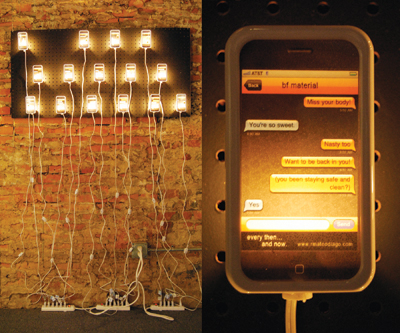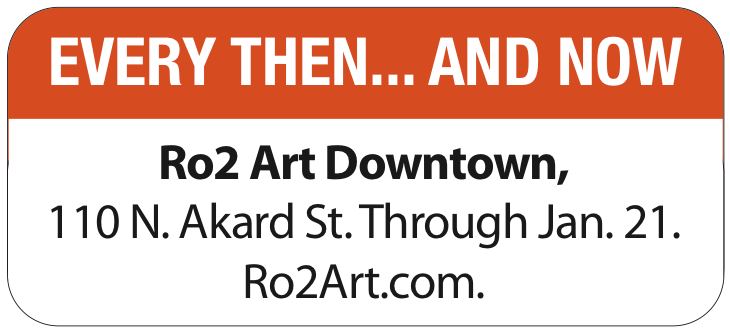‘Love addict’ Robert Diago uses his iPhone to explore his art

INSIDER ART | Artist Robert Diago lies in a bed which is part of the installation for his new show, which addresses his love addiction — something that has occasionally played out on his iPhone hookup apps, opposite.
RICH LOPEZ | Staff Writer
lopez@dallasvoice.com
Cell phone attachment is hardly uncommon among gay men.
Whether on the treadmill, during happy hour or in the middle of a date, that lifeline to the ether is always at hand, ready to be texted, dialed or simply held for reassurance.
But when one local artist takes a call, it’s not his date or his workout but his art that likely is being interrupted. For him, a smartphone is as important as a brush.
“It was never a conscious thing to make art from it,” says Robert Diago, “but it’s become something I’m using to create art while feeding some of the art I’m dealing with.”
In his new show Every Then… And Now at Ro2 gallery, Diago (who writes his name professionally as r. mateo diago) exhibits work that peers deeply into his inner conflicts and addictions thanks to his iPhone. Simply by taking pictures with his phone of other photographs, Diago discovered and honed certain degradations that resonated with his messages.
“There were these strange patterns what would occur and even with those old photos, this gave them a very modern, contemporary touch,” he says.
But there was also an underlying theme emerging. While examining his past and his love addictions with old photos, he was using the very tool that made his addiction harder to handle.
Using a hookup app as inspiration, he created a piece called “Findr Night Lights.” Diago freely talks about his codependence, which has manifested into a love addiction. While he may act out on that in some sexual fashion, he’s discovered it’s rooted in a lack of love and nurturing not met in childhood.
At least, that’s what his therapist told him.
“I had a very good therapist,” Diago chuckles. “As a love addict, I’m looking for that missing piece. I’ve learned that I need to treat the codependent in me, not the addict.”
In turn, his artwork has become therapeutic, and he’s been able to address childhood issues such as his father’s abandonment and an abusive grandmother. He even turned the ending of his last relationship into a four-piece narrative. Unlike his last show, Diago’s intention here is to leave more to the imagination and allow viewers not just to see him, but also themselves.
 “I felt like I spoonfed a little too much with [my show] Junk Drawer,” he says. “I thought to give less this time and start on some middle ground. The purpose of this show is to examine the buzzing in my head when it ingrained into my subconscious. I want everyone to take away from this that if you truly examine your thoughts, you can change the direction of your life.”
“I felt like I spoonfed a little too much with [my show] Junk Drawer,” he says. “I thought to give less this time and start on some middle ground. The purpose of this show is to examine the buzzing in my head when it ingrained into my subconscious. I want everyone to take away from this that if you truly examine your thoughts, you can change the direction of your life.”
The Jersey-born Diago followed his then-partner to Dallas 16 years ago from Fort Lauderdale. Back then, art was a part-time gig, but when he was laid off from his job as a graphic designer almost four years, his partner encouraged him to focus on his art.
Fast-forward to today, and the reality of being a full-time artist is arresting. Diago is still on the hunt for employment and his own money goes more into his art and booking shows than coming in as a result of it.
“I think it was a good decision, but it’s very tough,” he admits. I will just continue to do this, but with no income to speak of, I don’t know what’s next. I’ll definitely go where the money is but I do hope this show could be great for me.”
If there’s one thing his art has given back to him, it is a sense of forgiveness. He can accept he won’t have a relationship with his father but he can use him for art. And he’s also forgiven himself.
 “I love my journey. I chose all these unfortunate things and learned from them to create my work,” he says. “I came up against a lot of old demons in this work and was able to let go of them. It was one of the hardest things to do.”
“I love my journey. I chose all these unfortunate things and learned from them to create my work,” he says. “I came up against a lot of old demons in this work and was able to let go of them. It was one of the hardest things to do.”
There may not be an app for that, but Diago’s the man to ask how self-discovery can be found in an iPhone.
This article appeared in the Dallas Voice print edition January 13, 2012.













The whole show is wonderful so be sure to see it. It really shows how the things “buzzing around” in all our heads can hold us back until we are willing to examine them. Then we can begin to use all that has occurred in our lives with a good intent…hopefully. And really, there should be an app for self-discovery!
Cool, I’m not the first to comment…r mateo diago here, thanks for the feature Dallas Voice! Ditto what Lori B says.
And to DV readers, I’ll be at the gallery tonight (Friday 1/13, 5-10pm), stop by say hello, have a glass of wine, enjoy the show.
PS: I’m actually Puerto Rico born/Jersey raised and the Findr Night-Lights are individual pieces not one piece, so each is sold separately. You know you want one!
Good luck Robert, wish you’re old jersey friends could be there with you, we are in spirit…All success to you
Great Show! Really touches on how our minds create what shows up and how our feelings run us – if we let them. I want a night light. Robert putting himself out there – is the art.
All good artists tap into their dark sides…..but after a while you need to move on…and actually be able to create art…..the one thing Mr R. Mateo Diago has mastered is the art of self promotion….his interview reads like an advertisement for a Sugar Daddy.
Ms. Tod Riglet, did he turn you down hun?
Mastering the art of self promotion has helped many artist conquer the world. Just ask Madonna or GaGa or the dead Andy Warhol for God’s sake.
Almost every successful contemporary artist has become a master at promoting themselves…the few who haven’t were lucky to have someone else do that for them. How else will an artist in today’s world succeed when there are thousands of “unknowns” for every artist whose work is hanging in a gallery or museum?! The reality in today’s world is that it takes an amazing amount of selflessness to commit to being a full time artist. Artists give up a great deal to share their talents, visions & lessons with us. So to all the Teds/Tods out there who can’t face someone else’s truth & honesty without judging it…do us all a favor & take off your rose-colored glasses and look in a mirror.
dear Mrs Mothballs No i was not turned downed and frankly it was not worth it
as in his art it was very self serving and obiviously has issues on performance & intamacey….go back to being a house husband and have another fool build you a play house!
Yes so many artists that have great talent have not been able to share their gifts with the world. Promotion is often the key to getting anything in this world to move forward. Especially in this age of social media. You of course have to have to have talent….Andy Warhol, and Lady Gaga do….I wonder if Mr. Diago has any talent….just because you air your old demons doesn’t mean it is art… it may be cathartic but art is another thing.
@Tod R. and Susan F.–Mr. Diago does indeed have talent. His ability to tap his “demons” and turn them into something visually stimulating while doing it with incredible precision and visual interest speaks to that talent. Most people in his day that saw Van Gogh’s work either despised it, criticized it or laughed at it. Who’s laughing now?
There are PLENTY of art critics, curators and gallerists who couldn’t spot talent if it came up and smacked them in the face. It is appalling to me to see the hideous art that hangs on the walls of so many people with means…just because someone has money certainly doesn’t mean they have taste, and just because someone has an art history degree and 20 years as a curator doesn’t mean that everything they “bless” is worthy to be called art. In addition to the visual appeal and precision of his work, Diago doesn’t force his art…he lets it flow through him. He is the kind of artist that should make people stop and take notice. I’m guessing Tod R. may be seeing a bit too much of himself in Diago’s work.
As for Susan F.–you may want to consider the fact that Andy Warhol’s work was not all his own (it was a result of the environment/community in NYC at the time when sharing ideas and talents was “in”). His concept on the other hand was unique…creating a “factory” for making art, unfortunately he’s the only one who received real credit for the work done there. Lady Gaga is a very rare talent…she saw what she wanted and went for it using her innate talents. It was her persistence and drive that got her where she is (using her talents and uniqueness to convince the rest of us). I think there are certainly some parallels with regard to Diago’s work. Keep persisting RMD, only worry when people stop talking.